In late November 2021, I was lucky enough to travel to Uganda on a 9 day safari, joined by my husband and hosted generously on an educational tour by Classic Africa Safaris, The Wild Source’s main ground partner in Uganda (as well as Rwanda). Uganda’s people, landscapes and of course, its wildlife, absolutely blew me away from start to finish.
For anyone seeking a trip to East Africa that combines world class wildlife viewing, community interaction and involvement, and experiencing local culture in addition to your safari activities, Uganda far surpasses any other country I have visited when it comes to this unique combination of experiences.
-Emily Hancock, Safari Specialist
Entebbe
On Thursday November 22, we arrive at the Entebbe International Airport (EBB), after traveling from Denver to New York to Nairobi and finally (on the very last flight of our Kenya Airways pilot’s 44-year career!) we have made it to Entebbe – negative Covid test results in hand. We find the planeside VIP meet and greet service especially helpful with the additional confusion of on-arrival Covid testing at the time we traveled. (Note, as of March 2022, this requirement has been dropped).
Outside the airport, we are greeted by our guide, Robert Sunday, for a 15-minute drive through the city to reach our comfortable accommodations at the Karibu Guesthouse. On the way, we learn from Robert that Entebbe means “throne” – Uganda’s palace used to be located here, before the airport was built. The country’s presidential homes are still located in Entebbe.
We enjoy a dinner of soup and bread which the staff at Karibu kindly prepare for us despite the late hour of the night, and then retire to our well appointed room for showers and sleep – the best two things after 24-plus hours of plane travel!
The following morning, we are elated to have coffee on our private porch listening to a raucously beautiful symphony of birdsong and taking in the stunningly colorful and lush gardens surrounding the Karibu Guesthouse. After breakfast, we meet for a briefing with Lydia from Classic Africa, and set off in our customized safari vehicle with Robert, who is a senior guide with over 10 years of experience with Classic alone.
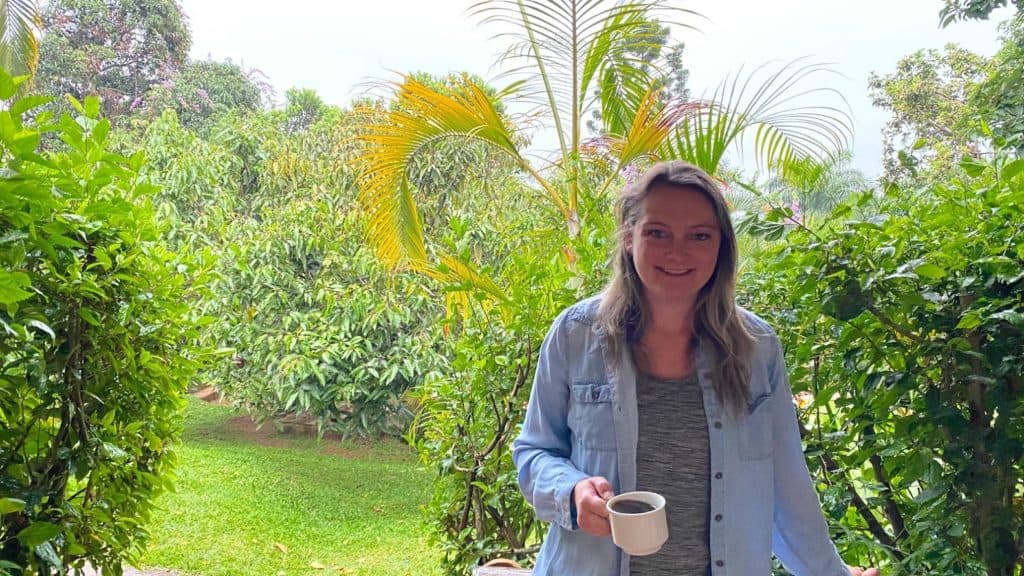
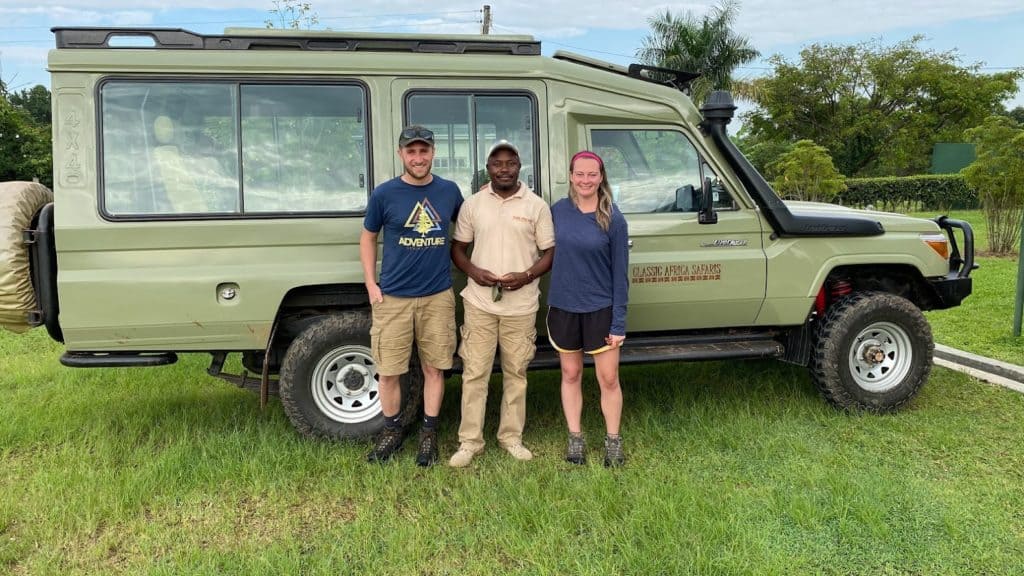
The drive from Entebbe to the Fort Portal region takes close to a full day, and we see a great variety of towns and local life, along with changing scenery as we drive through the countryside. We pass several Papyrus swamps and navigate among “bota botas” (imported Chinese motorcycles) that have become by far the most common form of transportation in many East African countries. We are surprised to see a species of pine trees (familiar to us here in Colorado but invasive to Uganda) and eucalyptus (also invasive).
Visiting at the end of November, we are just on the tail end of the rainy season, meaning extra bumpy washed out roads. Robert navigates the challenging roads and busy traffic like an expert though, somehow able to also maintain conversation, teach us a plethora of facts about Uganda along the way and share some of his story as well. We pass through Mubende, a town in the central Buganda region of the country, where Robert’s wife and youngest son now live. Robert tells us he is from Mpondwe, a small village on the western border of Uganda and the Democratic Republic of the Congo.
We identify fire brush, jacaranda, bougainvillea and yellow oleander trees as we drive along, and the occasional tea farm (which we will see much, much more of later in the trip!) Robert explains that the tea plants are grown on the edge of the forests to help keep primates from raiding croplands as they don’t favor tea leaves in their diet.
Further on, Robert spots a black headed heron, and shortly we are passing a troop of surly olive baboons parked on either side of the road. We laugh and laugh as the baboons chase a gentleman on a bota bota with a huge cassava strapped to the back – the hungry baboons nearly snatch it off his bike.
(The alternative option to driving from Entebbe is to fly from Entebbe to the Kasese airstrip, and drive 1-1.5 hours to one of the lodges in the area).
Kyaninga Lodge
After a winding climb to the top of a forested hill, past many villages, houses, and farms, we reach Kyaninga Lodge, located on the edge of a stunning crater lake and overlooking the town of Fort Portal below and the Rwenzori Mountains in the distance.
Kyaninga Lodge is a major supporter and leader of several community-oriented projects including a forest foundation, mobility workshop for children, a school, and a dairy farm. We are given the grand tour by assistant manager Escovia, who has been with the lodge since before it even opened – helping sand logs and weave mats as the lodge was being built, then a waitress, head waitress, and now the head of staff. There are 9 cottages, a main dining and lounge area, outdoor patios, a pool and a spa. Activities include kayaking and swimming in the lake, a walk around the lake, or checking out any of the many community projects named above.
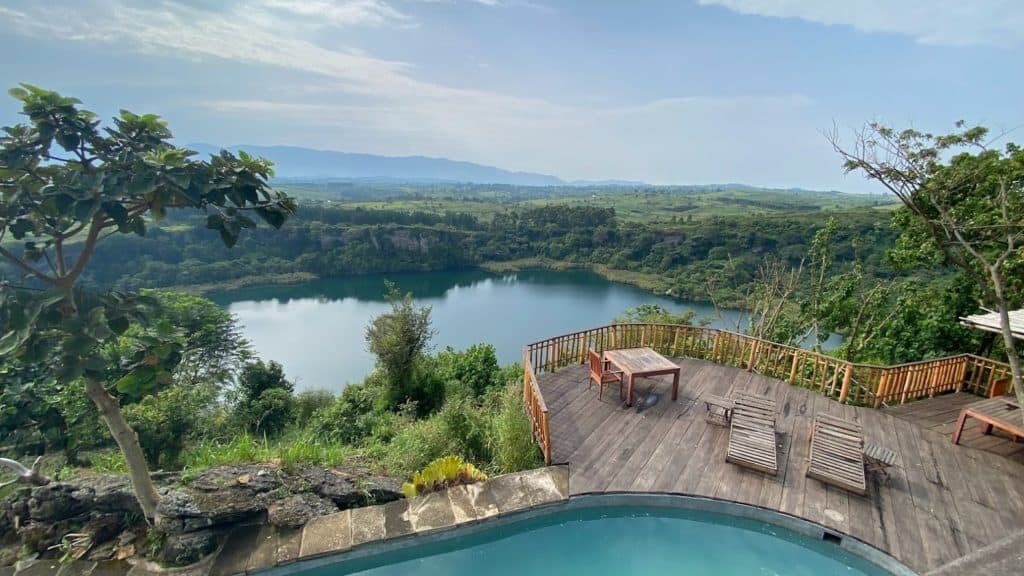
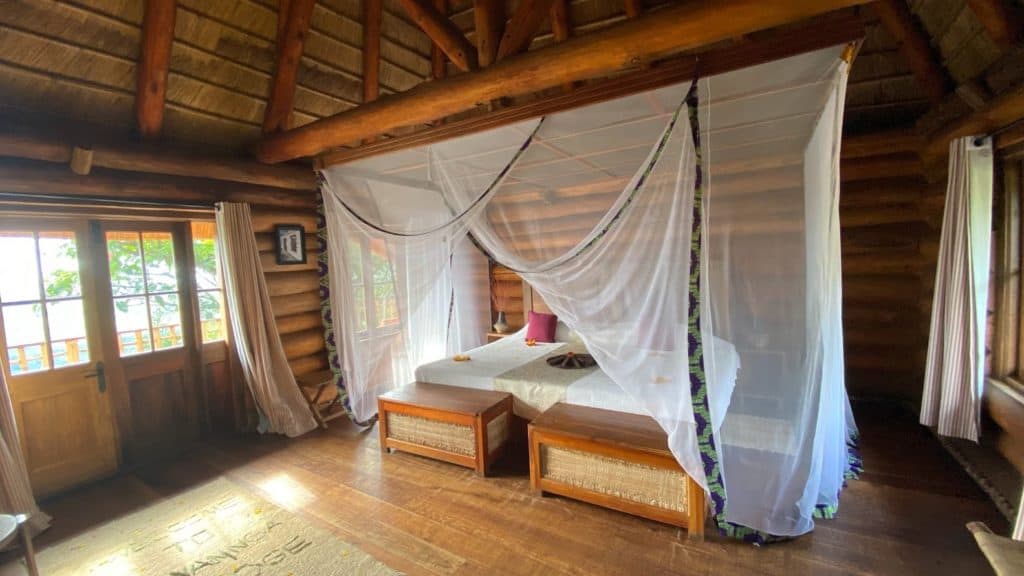
We have just enough time this afternoon to go for a walk around the crater lake, led by our walking guide Peter, a local of Fort Portal who can speak no less than 13 languages. Despite a surprise bee sting on our walk, it is highly enjoyable and we frequently pause to take in the gorgeous views. We spot vervet monkeys and black and white colobus monkeys in the canopy above us. On the opposite side of the lake from the lodge, we encounter a few groups of local farmers tending crops. Eventually we make our way through the forest on the far end of the lake, past more farms, homes and a few other cottages / lodges, before we arrive back to the lodge for dinner and the night.
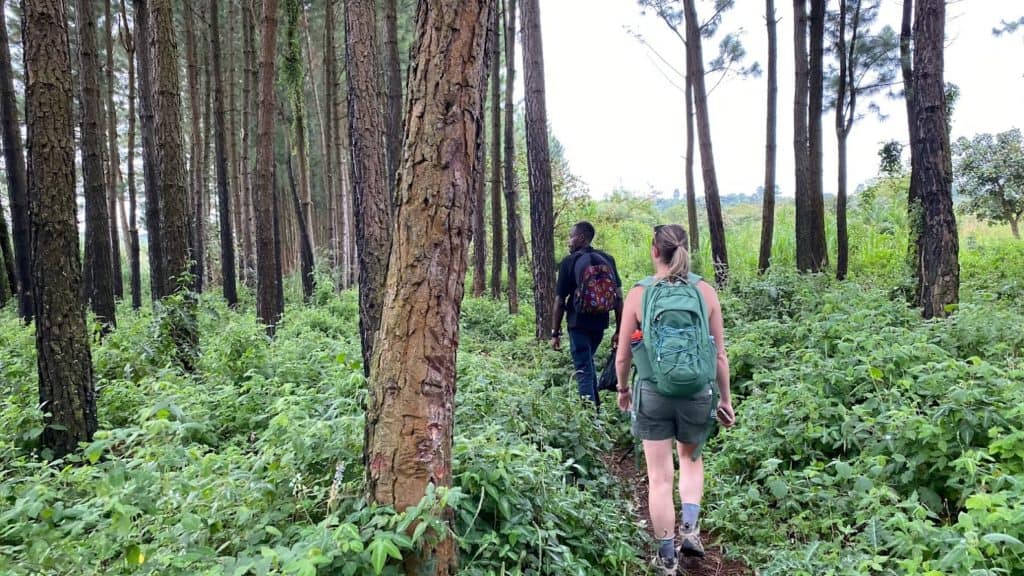
Kibale Forest Chimp Trekking
We depart the lodge at 6:30am for the drive through Fort Portal and onward to Kibale Forest National Park. It takes about 1 hour and 15 minutes to reach the Kanyanchu Visitor Center where we are debriefed by Uganda Wildlife Authority (UWA) rangers on chimp trekking etiquette.
On the Kibale trek, it is technically possible to see up to 13 primates including chimpanzees, red-tailed monkeys, black and white colobus monkeys, L’Hoest monkeys, vervet monkeys, olive baboons, blue monkeys, Uganda red colobus, bush babies (Demidoff Galago), the potto, Patas monkey, and Uganda mangabey. Most visitors will see over half of these species – we end up seeing the first 6 listed here. In Kibale, there are approximately 1,450 chimpanzees.
We set off with our UWA ranger guide, Ali, for what turns out to be about 3.75 miles of trekking. After about an hour (and one incident with safari ants later…) we locate the troop of chimpanzees, first coming across a large mature adult male named Ndali (estimated to be 38 years old). He is perched in the low branches of a tree, at eye level with us. After a couple of minutes, he climbs down and walks past us to climb another, much higher tree. We feel incredibly fortunate to have come face to face with him – to look directly into the eyes of man’s closest biological relative (humans and chimpanzees share a stunning 98.8 percent of our DNA). Staring back at this near human face, you can just instantly feel that you are looking into the eyes of a creature that is thinking, reasoning, evaluating – a creature with personality and social dynamics so similar to our own.
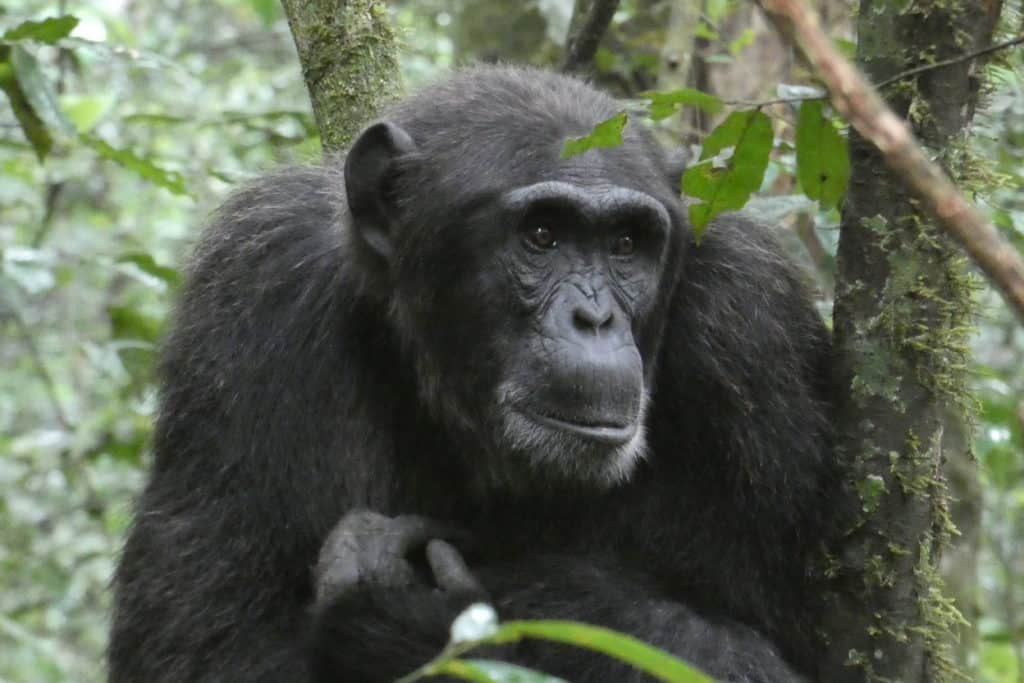
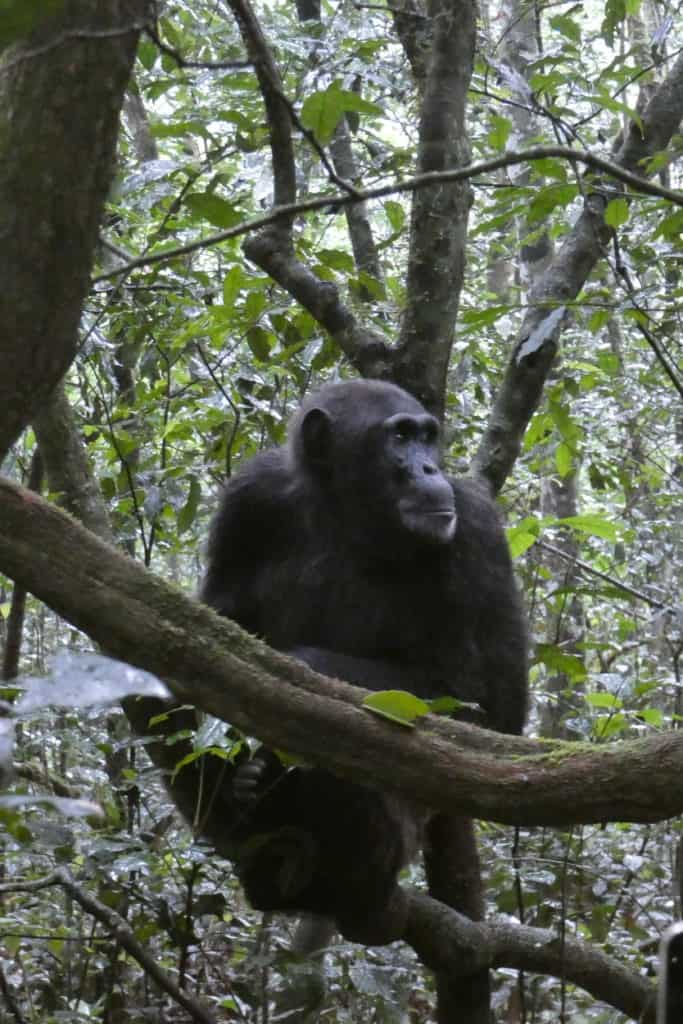
The rest of the chimps – about 30 – are high in the tree tops and we crane our necks to observe their behavior but we have no trouble seeing (and hearing) what is going on. We observe a female and male pair mating on a high tree branch, followed by 3 males exhibiting behavioral displays and vocalizations to try and woo this female. They are likely younger adolescent males fighting for their chance to mate with the females in this group. We observe another chimp making a temporary nest, as he folds down branches in a crisscross pattern to create a basket to lay in. This is unusual behavior to be able to witness during the day, since nests are typically only made at night before sleeping. It appears this guy has opted to make a “nap nest”.
As our hour with the chimps comes to a close, a torrential downpour begins and now it really feels like we are in the rainforest. We hike all the way back in mud and pouring rain, reaching the visitor center again where we bid our ranger guide farewell.
We take a quick look at Primate Lodge, which is the only tourist lodge located within Kibale Forest National Park, just up the road from the visitor center. As we are checking out one of the bandas, we see a red-tailed monkey and a baby L’Hoeste monkey from the porch. We hear that once in awhile chimps even come to lodge.
Following our trek, we enjoy a special traditional meal at the home of a local community member, Tinka. Tinka’s daughter Bridgette is our host for lunch which is a culinary roundtable of maize, bananas, pumpkin, sweet potato, Irish potato, rice, Ankole beef, beans, cabbage/spinach, avocados with chili, peanut sauce (purple in color!) and delicious chapati bread. We don’t have time for a walk at the Bigodi swamp (allow for about 3 hours) but pass by Bigodi on our way from Tinka’s.
We visit Ndali Lodge next, passing through the town of Wehamba first. Ndali is a bit closer to Kibale (you can set off at about 7:00-7:10 for 8:00am chimp trekking). The owner Aubrey (who lives on site) gives us a tour of the property, also located on the stunning edge of a crater lake down below. There are 9 cottages, an outdoor gym, sauna and a pool. Activities available include paddle boards, a walk around the lake, walk around the estate and a bird walk, or a visit to Wehamba for local interactions. They are also putting in a croquet lawn and tennis tarmac. My personal favorite part are the 3 dogs that live on property and join us for the full tour.
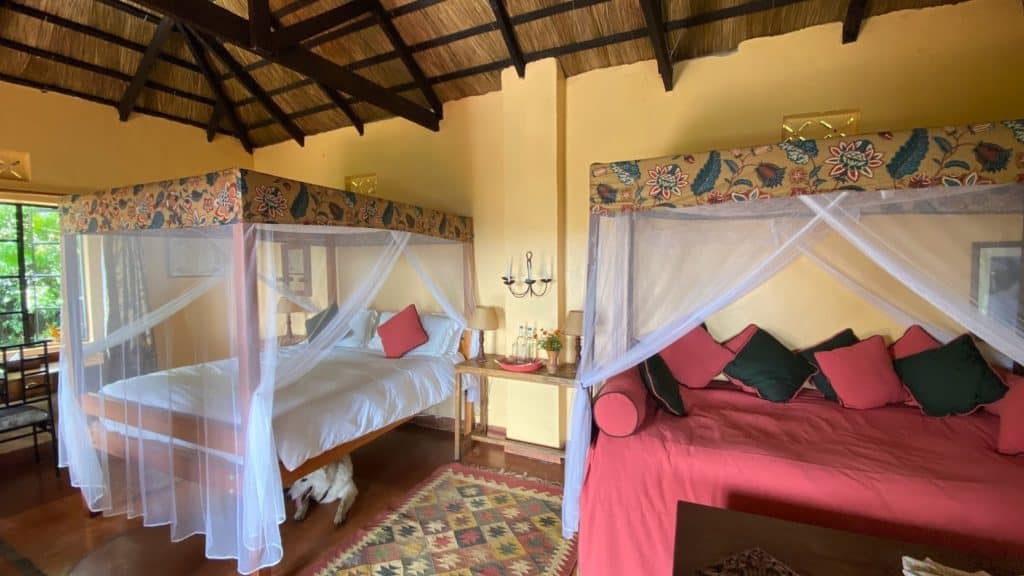
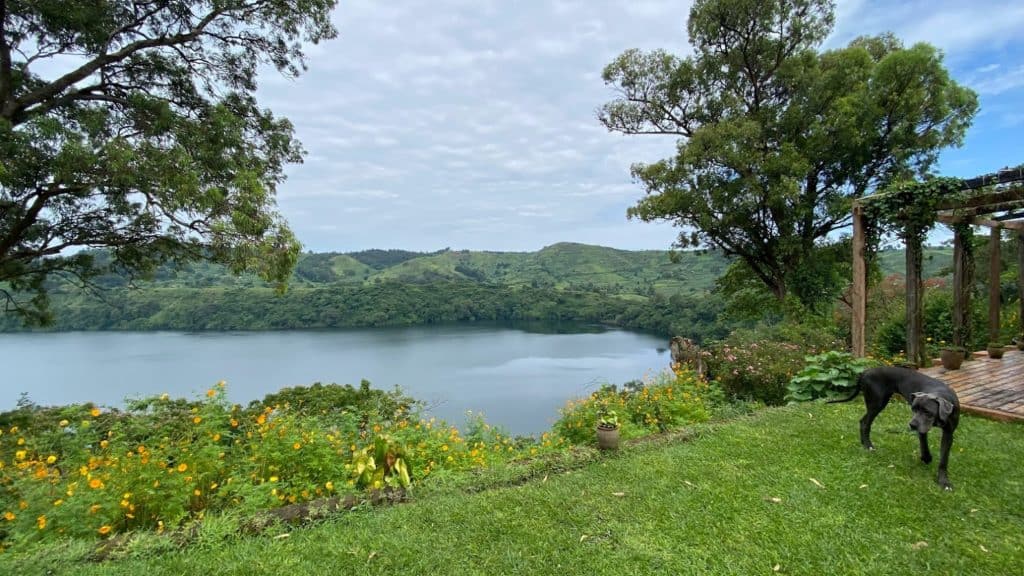
Queen Elizabeth National Park and Kyambura Gorge
We set off early the next morning as we begin our drive to Queen Elizabeth National Park and Kyambura Gorge, our next destination. As we drive, Robert tells us Classic has the best reputation among tour operators in Uganda and it has always been his dream to work for them. Robert tells us the story of his grandfather, who lived to be over 100 years old and helped demarcate the boundaries of the Rwenzori National Park. He tells us his people, the Bakongo tribes, are known for their strength. They fought many years to take their land back after it was taken by the Rutooro tribes.
We pass pink and orange Angel’s Trumpet trees and Fig trees. We learn that the fig tree is traditionally a very respected and significant tree in Ugandan culture, and is typically used as a burial marker at the grave of a prominent man. The first Ugandan clothing was made from the bark of the fig, and the phrase “where is your fig tree?” means “where are you from?”
We pass through Rwimi, the final town of the Bunyangabu district. The river which flows down from the Rwenzori mountains splits the border and we are now in Kasese district. Passing a tree full of weaver nests, we are reminded of the funny yet industrious nature of these little birds – one small nest can take about 6 days of work by the male, in order to woo a female – if she is not happy with the house he has built, she can destroy it in seconds! Once she IS happy with the nest a male has built for her, they will mate, and he will remake a new nest every breeding season.
Continuing on toward the town of Kasese, a live pig takes the new prize for “weirdest things we’ve seen on the back of a bota bota”. We drive past the prison fields where inmates grow cotton, corn and sunflowers, and through an industrial area of cement factories and a hydroelectric plant. We reach bustling Kasese (population roughly 80,000 people, bigger than Fort Portal’s 55,000). After a stop for fuel, we cross the equator and enter Queen Elizabeth National Park. Sightings as we drive include several elephants – solitary bulls mainly, including one who trumpets and bluff charges us before crossing the road – Ugandan Kobs, Cape buffalo and warthogs. The highlight is the elephants, of which there are over 2,000 in the park.
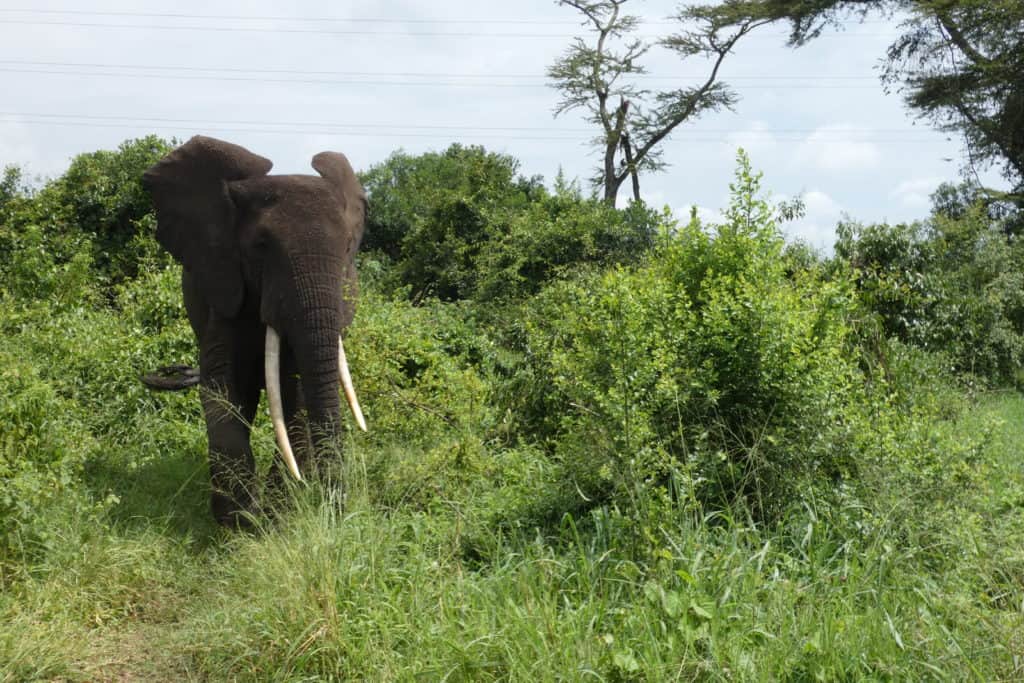
We drive through the savannah and up and over the escarpment of the Great Rift, reaching Kyambura Gorge Lodge in the early afternoon. Kyambura Gorge is known for a population of about 25-27 chimpanzees, though the trekking here is more challenging and traditionally sightings of the chimps are rarer. In recent years however the chimps are becoming more habituated and easier to locate and spend time with.
Kyambura Gorge Lodge is a stunning property, part of the Volcanoes Safaris portfolio, and we are assigned our personal butler, Beatrice by the local manager Priscilla – both are warm, friendly and fantastic women to spend time with. There are 8 cottages, a swimming pool, and expansive main dining and lounge areas. The food here is indescribably delicious as well. On the walks to and from our cottage, we discover there is a resident Angama lizard, which basks in the sun and blows us away with its vibrant blue colors.
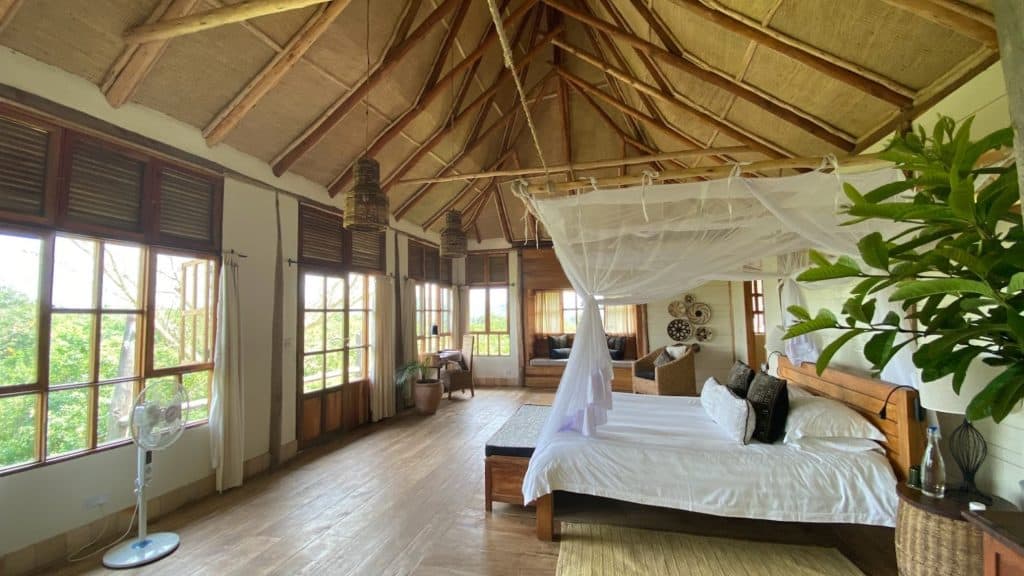
Volcanoes Safaris Partnership Trust Center
After settling in, we visit the Volcanoes Safaris Partnership Trust (VSPT) Center about 10 mintues away, to learn about and participate in the various community projects supported by the lodge. At each Volcanoes property, there are different community projects and it is a really informative and interactive experience that is a bonus of staying at these lodges.
At the Kyambura Gorge VSPT center, there are 8 different projects, including the successful Women’s Coffee Co-op. Local vulnerable women are hired to produce coffee at every stage from the growing of the coffee beans to drying, peeling, grinding and roasting the coffee until it’s ready to drink. There are currently about 20 members, 30% of which are HIV-positive and the remainder are widows.
Other projects include making soap for the lodge and running a community café where local disadvantaged youth (orphans or those with single parents or HIV-positive parents) are trained in hospitality and life skills for 6 months (typically interning for 3 months at the community café and 3 months at the lodge). As of the date of our visit, 53 students had graduated and 7 are now staff at the lodge (including Saeed who is our guide for the VSPT activities, and our lovely butler Beatrice).
There is also a Conservation Center meeting hall at the VSPT center where community meetings are held to educate the local community on the importance of wildlife and habitat conservation. The VSPT Center and local community rallied in recent years for the restoration of a wetland nearby. They restored 45 acres from a brickmaking facility back to its natural wetlands. Now, over 203 bird species, monitor lizards, pythons, cobras, red tailed monkeys, black and white colobus monkeys, rare sitatunga antelope and even chimps have been spotted in the wetlands. It is an incredible grassroots conservation success story.
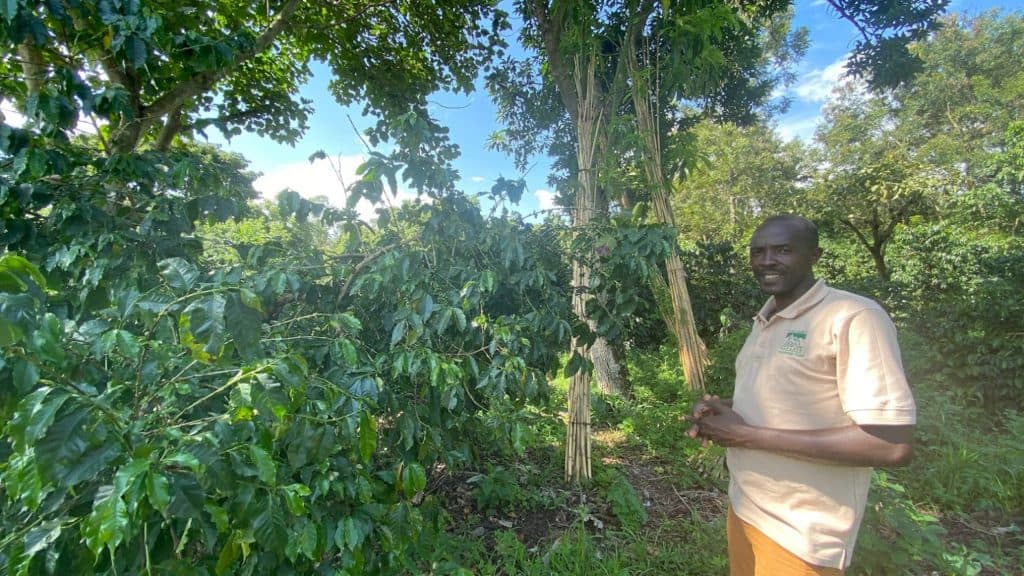
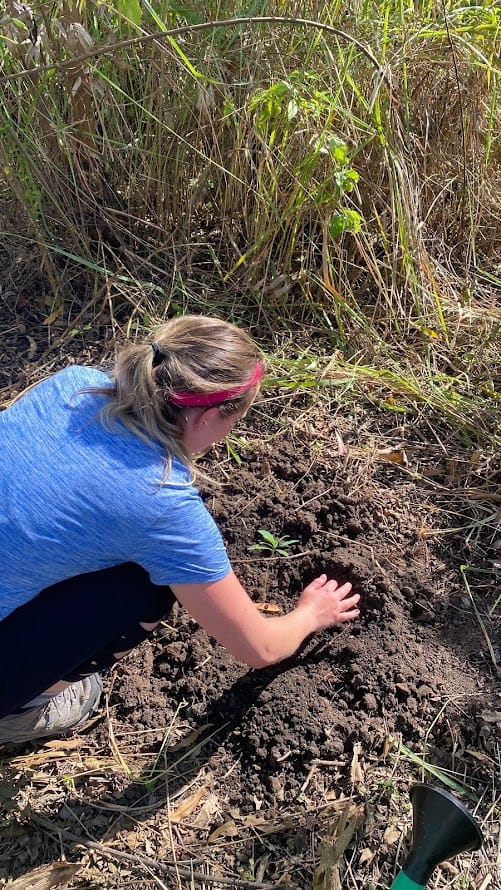
Another special project supported by the VSPT Center is the Buffer Zone, an area that used to be croplands between the community and the Gorge. Primates were raiding the crops and being poisoned as a result. VSPT has planted a wide buffer zone of trees in this area, pushing back the boundary between Gorge and community, thus protecting both parties from human-wildlife conflict and loss of habitat / species in the Kyambura Gorge. Plant a tree – save a chimp.
During our visit, we tour the coffee gardens and participate in the coffee making process from start to finish (and with a donation to the VSPT center, head home with our own bag of Ugandan coffee!), plant a tree each in the Buffer Zone, and hike down into the Gorge for a guided walk of about 2 miles total, hiking out on the other side and following in the footprints of elephant and buffalo. We stop at a pagoda that is about 30 minutes from the access trail to Fig Tree Camp where the chimp treks for Kyambura Gorge begin, and eventually return to the Lodge on foot.
Kasenyi Plains, Kazinga Channel and Ishasha
The next morning we head out well before sunrise with the goal of being one of the first vehicles into Queen Elizabeth National Park. The sun is just rising as we enter the park, and after waiting a few minutes on the park rangers to (literally) wake up and come collect our park fees, we game drive into the park. With the rooftop popped open, we stand and scan for any sign of movement – our hope is set on lions, but we know it’s a rare sighting here in QENP so try not to get our expectations up too much. As we drive across the Kasenyi Plains, Robert tells us there are 11 communities within QENP – it’s a unique park in this way as the communities were not displaced when the park was formed, but rather attempt to live in tandem with the wildlife and continue their fishing commerce on the edge of the lakes.
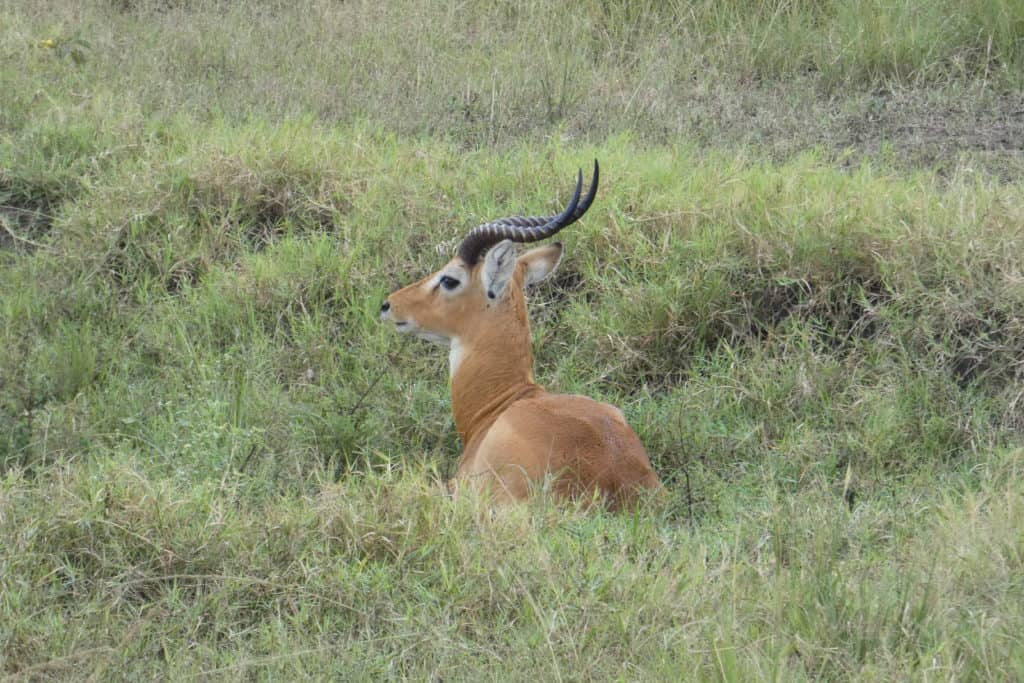
We spot a red-naped spur fowl, a family of warthogs, and several groups of Ugandan kobs – first, a bachelor herd, and then a group of females with babies – one tiny calf is just about a week old Robert estimates. We are excited over the kobs and then just like that, we come around a corner and there are 1…2…3…. 10 lions lounging in the middle of the dirt game track we are driving on! There are no other vehicles in sight and we can’t believe our good fortune (and good timing) has paid off.
We spend a solid half an hour observing the pride, made up of several adult females, including the leader Bridget who is 11 years old and wears a research collar, adolescent males and females, and young playful cubs. The weather adds to the drama as the sky turns all shades of gray and dark blue, and rain begins to spit from the sky, then come down in earnest. As the rain comes, the lions move from their meandering along the road into cover in some bushes. Bridget stays atop a large rock, watching the horizon and perhaps scanning for prey. After 30 minutes alone with the pride, another vehicle, and then another, arrive as the lions are hunkering down in the bushes. Having spent a private morning on the road with them, we move on.
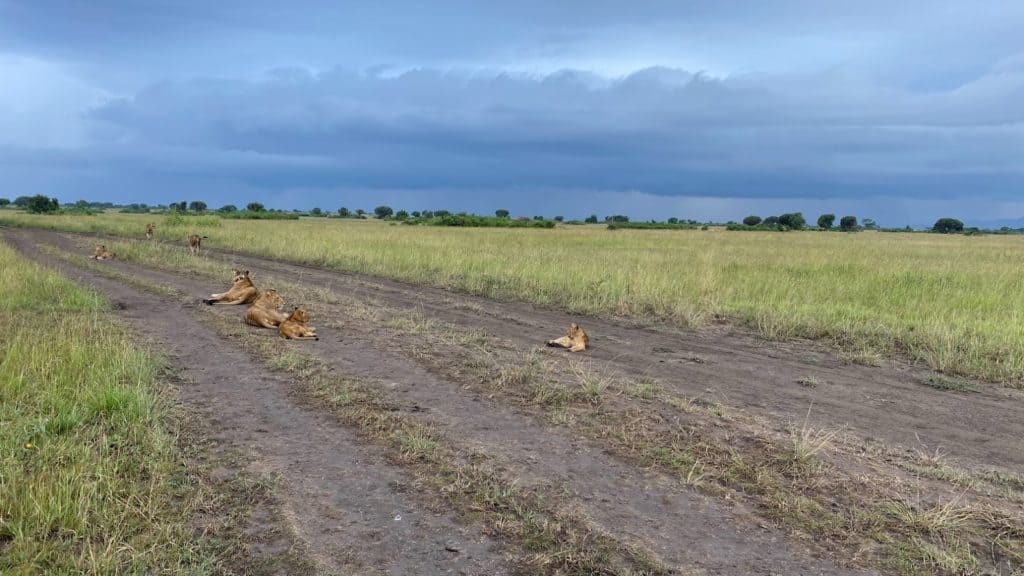
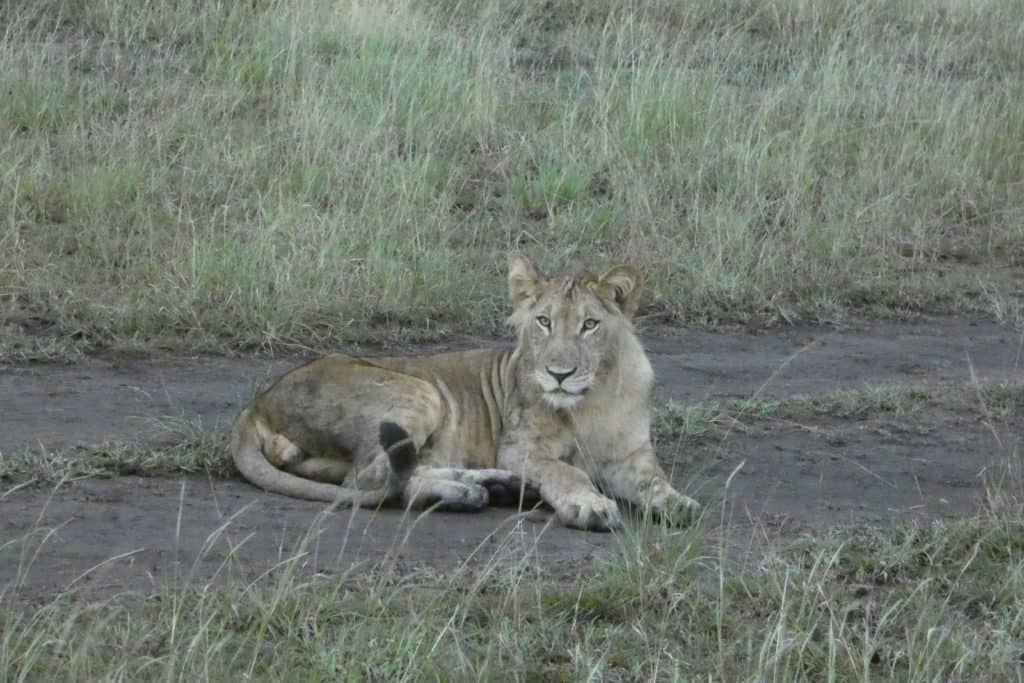
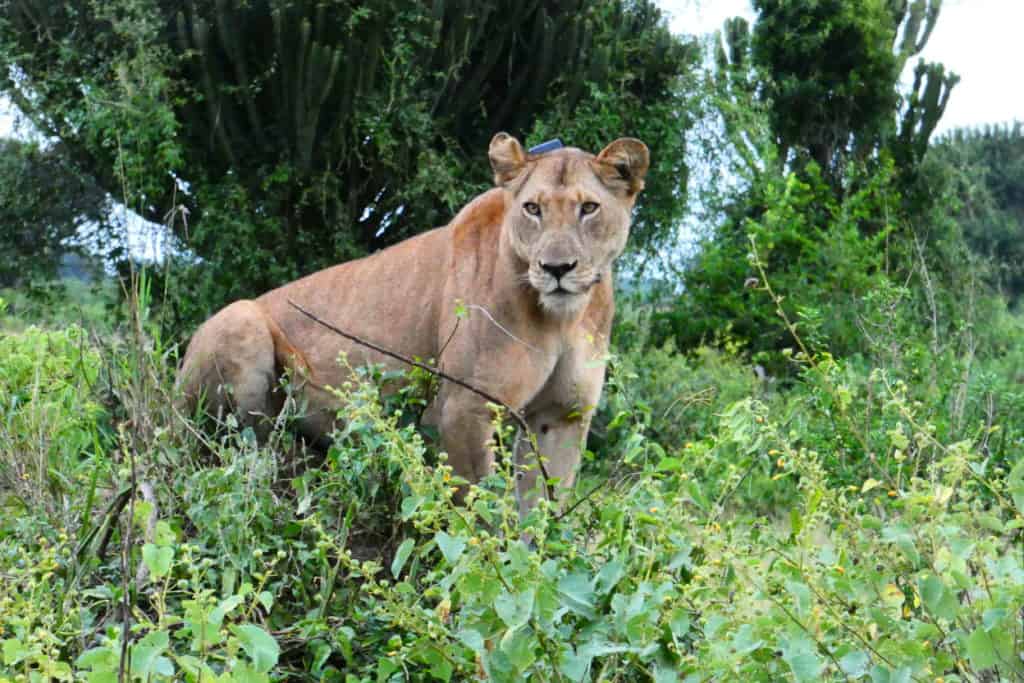
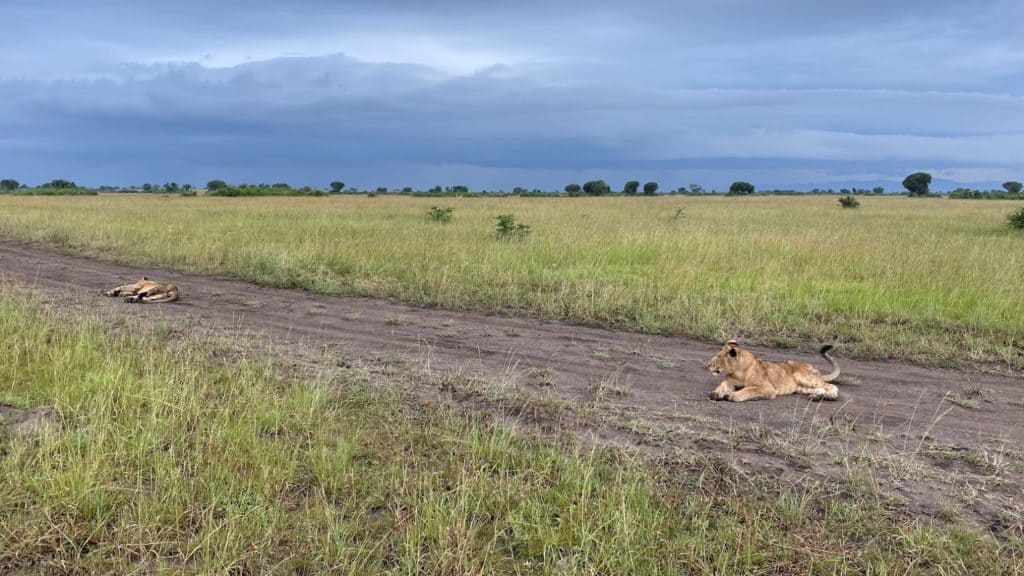
We have our picnic breakfast near a herd of buffalo – interestingly, there are Cape buffalo, forest buffalo and an interbred hybrid of the two. We can tell the differences by their coloring – the forest buffalo is redder in color than the dark brown Cape buffalo, and the crossbreed is somewhere in between.
Our first spotting of the Ugandan national bird is next – two beautiful Crested cranes. As we exit the park, we are in a flurry of swallows that fly along with us as our vehicle disturbs insects and kicks up a nice meal for the swallows. The word “murmuration” comes to my mind. We see a bushbuck, predictably, in a bush, and a pod of hippos in a pond that looks way too small for them. One has enormous wounds from territorial fighting. We spot a waterbuck, the largest antelope in QENP, and the perfectly named Hamerkop with it’s hammer shaped head. Other notable bird sightings include Egyptian geese, yellow-billed egret and a long-crested eagle.
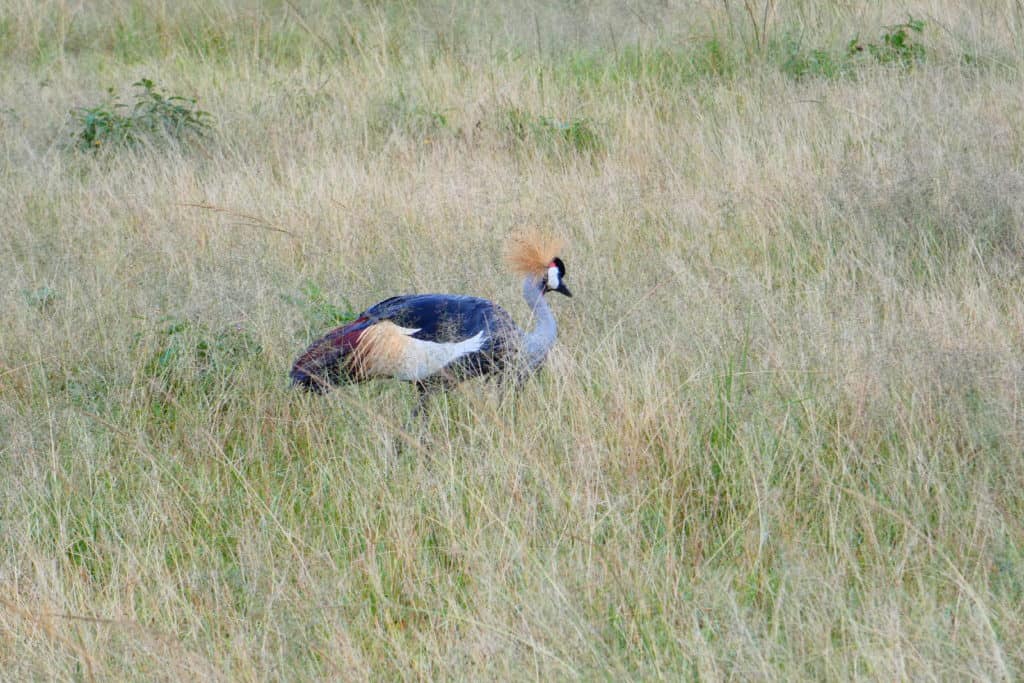
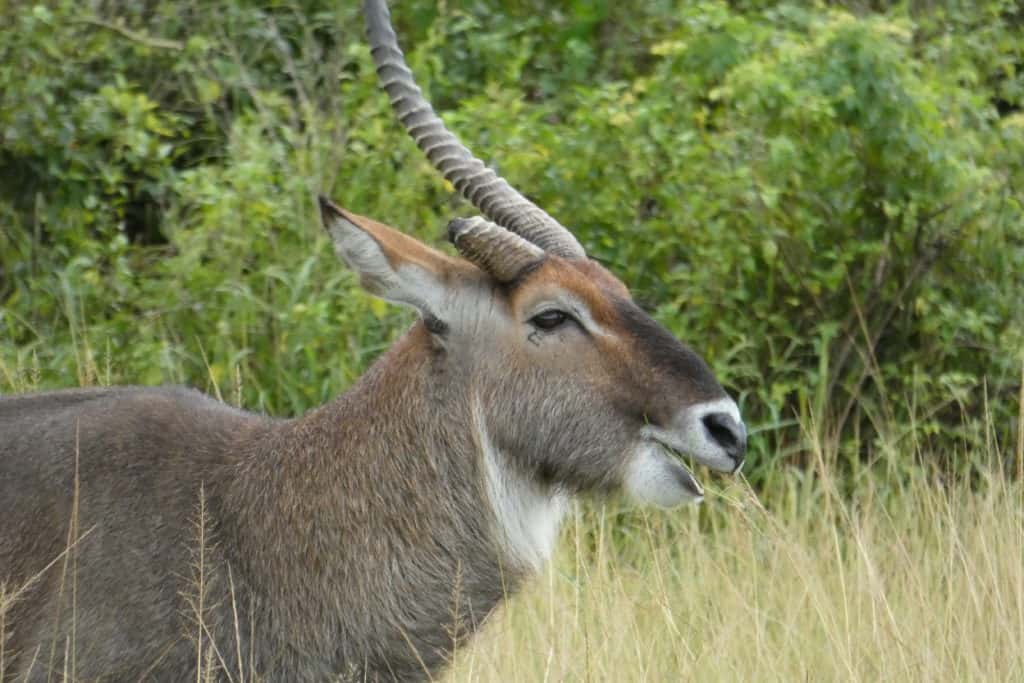
We spot more elephants as we drive along toward the Kazinga Channel, and herds of buffalo scattered along the edges of the sulfuric and sodium crater lakes – apparently, the buffalo gather here for the healing properties of these minerals. Shortly before 11:00, we arrive at Mweya Lodge, where our boat ride will launch.
The Kazinga Channel is a wide, 32-kilometer (20 mile) long natural channel that links Lake Edward and Lake George, and is a dominant feature of QENP. The channel attracts a wide variety of animals and bird life and has one of the world’s largest concentrations of hippos and Nile crocodiles. There are a few different operators running boat tours out of the Kazinga Channel, but we are on a private boat called the Sunbird (started by Robert actually, his very first guiding operation was running this boat).
The boat ride is an outstanding break from being in a vehicle and viewing wildlife from the water offers a perfect change of pace at the middle point of our trip. As we glide through the water and along the shores, our knowledgeable guide points out hippos and their young both in the water and grazing on the shore, buffalos soaking in the mud at the water’s edge, black and white kingfishers, malachite king fishers, numerous crocodiles, a yellow billed stork, an ibis, a Goliath heron, giant monitor lizards running along the sand and both juvenile and fully mature pairs of African fish eagles.
We witness hippos mating – two pairs, both in the water – and adorable baby hippos grazing on shore and doling out grumpy looks directed at us. Cormorants, pelicans, and Maribou storks add to our bird sightings. Toward the end of the boat ride we spot several elephants. There are about 6 in total, tearing at tree branches and grass along the shore of the channel. We watch them for a long time, then go all the way to the edge of Lake Edward, where we gaze across the lake to the mountains of the DRC just a handful of miles away. In between us, local fisherman ply the waters of Lake Edward in this unique park that combines daily life and commerce with conservation. Ultimately, I feel incredibly small as I look out at the Heart of Africa.

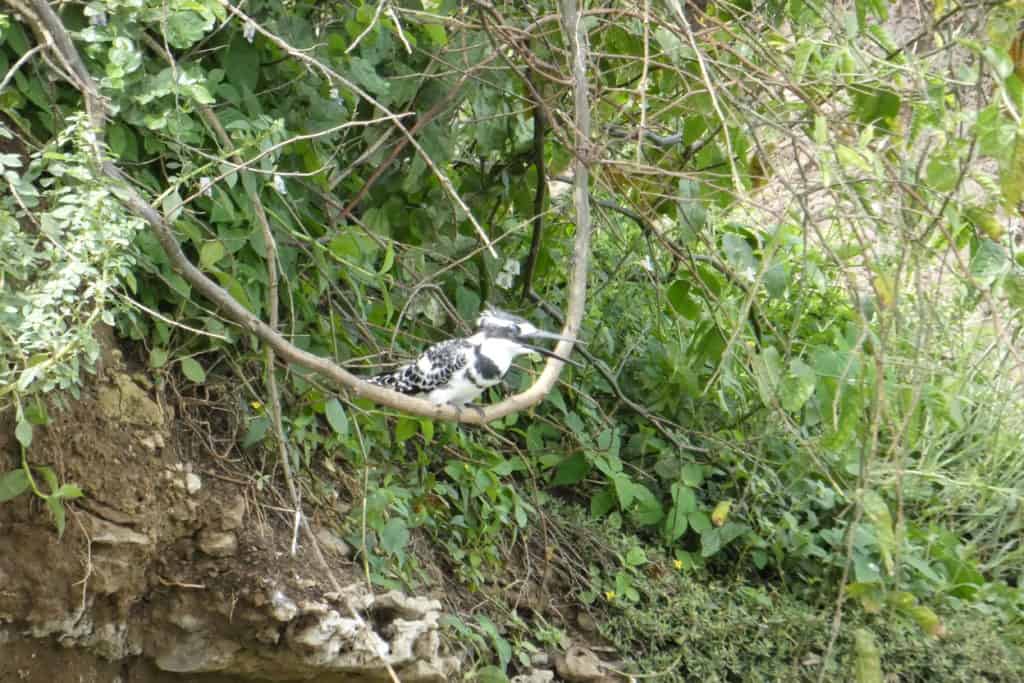
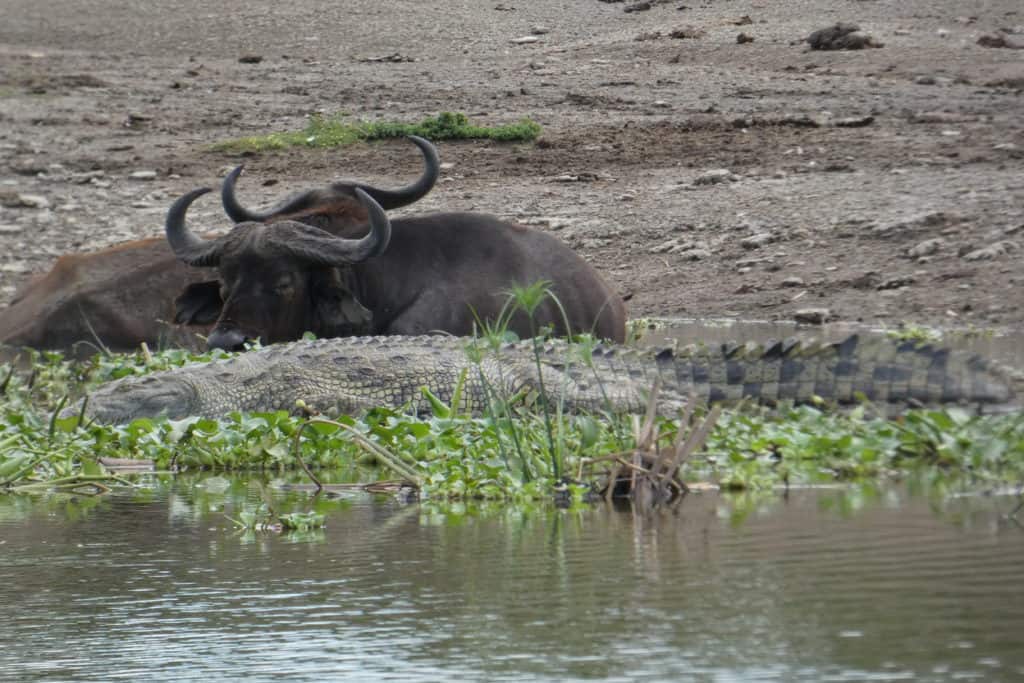
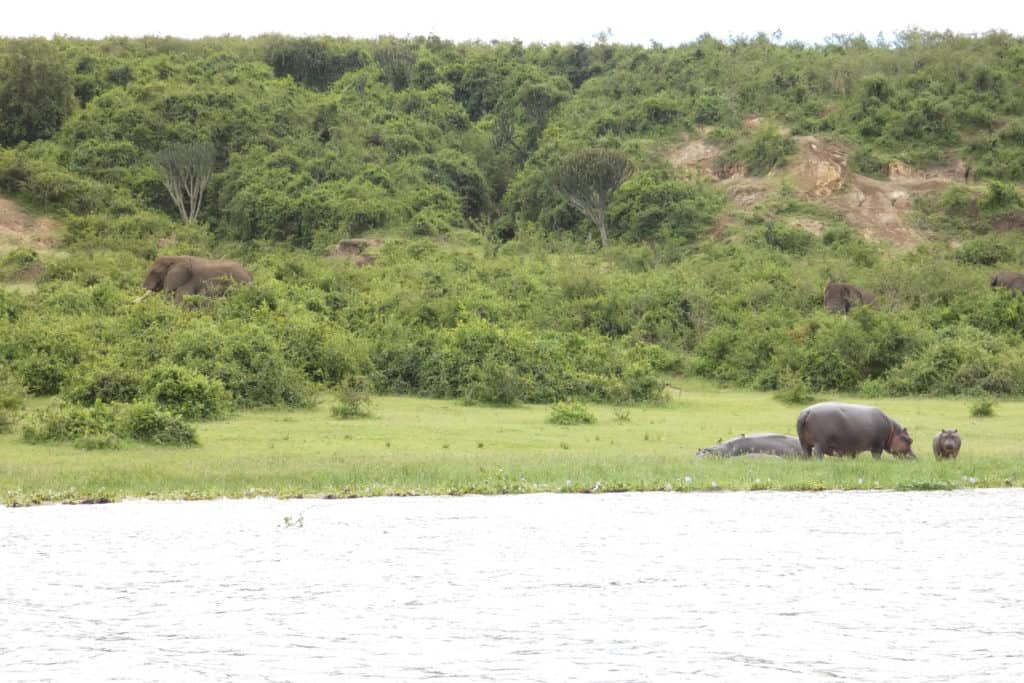
Following our boat ride, we depart in our vehicle and drive a different route out of the park, game driving on the Channel Tracks just adjacent to the Kazinga Channel. We stop short as a massive solitary bull elephant greets us in the middle of the channel tracks. He slowly ambles onward and not moments later, a whole breeding herd sways past us in the bushes just next to the road. The matriarch flaps her ears at us in a defensive gesture, trumpets loudly and bluff charges us before deciding we are no threat to her herd. It’s thrilling to say the least. We spy more warthogs and waterbuck before arriving back to the main road and our junction to head toward the Ishasha sector of QENP.
From leaving Mweya Lodge to reaching the heart of Ishasha’s game driving area, takes us about 3 hours on challenging bumpy roads. One thing we are learning is that Uganda is not for those who dislike off-road driving! (But, it’s worth it a hundred times over!)
We arrive to the Ishasha sector, famous for its tree climbing lions. Robert tells us there are 23 lions in Ishasha. We game drive along the northern tracks in search of the lions to no avail, so we decide to head to the southern sector next. We don’t have any luck in the south either, and are getting short on time as we have to make it to Bwindi tonight, so we head out of Ishasha. Heartbreakingly, as we leave, Robert gets a call on his radio that lions have been spotted on the main road into Ishasha – looks like we used up our good fortune on the Kasenyi Plains lions! Regardless, we are just happy to have seen these big cats in Uganda at all, a much more challenging feat than in the traditional big five safari regions of the Serengeti and Masai Mara where the big cats have far greater numbers and range.
We leave Ishasha and QENP, and drive into the Kanunga district, home of the Bakiga tribes – known as the hardworking people. We pass through Kihihi town (population approximately 25,000) and after a winding, beautiful drive through the foothills on the outskirts of Bwindi, we arrive to Buhoma and check in at Mahogany Springs Lodge around 8:15pm for a late dinner and night of rest. Mahogany Springs is a great mid-range luxury lodge with a location in Buhoma about 10 minutes from park headquarters, with stunning views of the Bwindi forest and local farms and tea fields. There are 9 stone and thatch bandas plus a deluxe honeymoon banda and two-bedroom family suite.
It has been an incredibly long day but packed full of amazing wildlife, scenery and adventure. For those who have time, I highly recommend spending 2 nights in the QENP area for a more relaxed pace and more time game driving in the Kasenyi Plains and Ishasha sector.
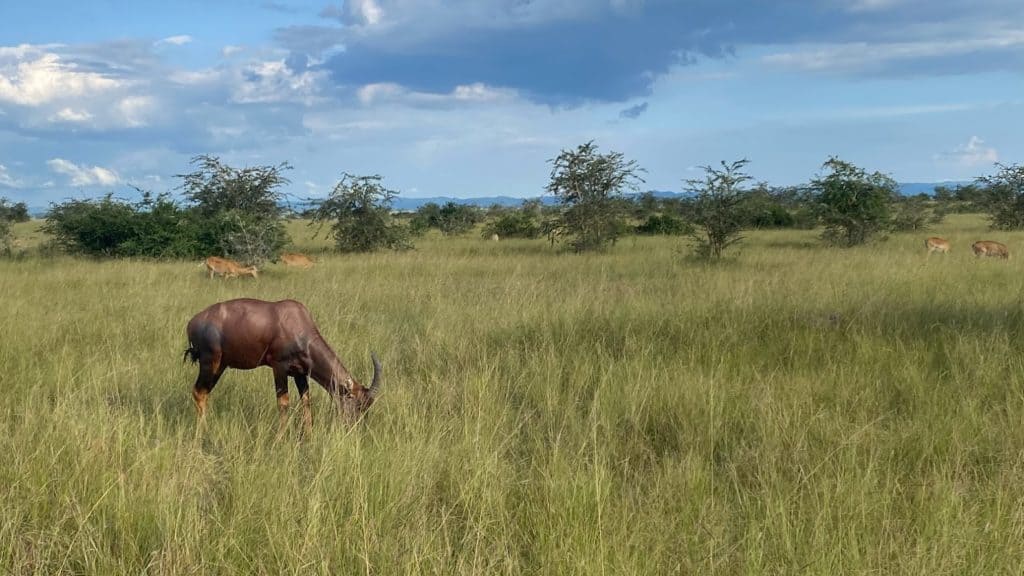
Bwindi Impenetrable Forest and Gorilla Trekking Day 1
Gorilla trekking in the Bwindi Impenetrable Forest is the grand finale, and really – main event – of our trip to Uganda. Uganda is one of the only places in the world you can see mountain gorillas (Gorilla beringei beringei) in the wild, the other being Rwanda. In the Republic of Congo, you can trek to see western lowland gorillas. Mountain gorillas also live in the Democratic Republic of Congo but there is no tourism.
As of our trip in November, there were 459 endangered mountain gorillas in Bwindi (including one very newborn infant!) This represents an increase of 59 individuals since the previous survey estimate in 2011 of 400. The total number of mountain gorillas in the Virunga Massif across Uganda, Rwanda and the DRC is numbered at 1,069 at last count. With so few individuals in the wild, the mountain gorilla is listed as a critically endangered species (the mountain gorilla population hit an all-time low of just 242 individuals in 1981).
Bwindi’s national park was gazetted in 1991 for tourism – I highly encourage you to read The Impenetrable Forest by Thor Hanson, a Peace Corps volunteer who helped start the mountain gorilla tourism program in Bwindi, for a humorous, poignant memoir and great history of tourism in Bwindi. Responsible gorilla trekking tourism in Rwanda and Uganda is one of the greatest conservation success stories of our time, and protecting the mountain gorillas’ habitat and population through trekking tourism has helped preserve and slowly increase the number of remaining mountain gorillas on our planet.
We arrive to Park Headquarters for our first day of trekking, and after Covid screening protocols, fantastic entertainment by the ladies of the Ride 4 a Woman Project, and a briefing on gorilla trekking etiquette, we are assigned to visit the Rushegura group with our small trekking group of 8 guests. We each travel with a local porter (essential jobs for local people in Buhoma), our head guide from the UWA, 2 armed rangers and a team of 3 trackers.
The trackers are crucial to locating the gorillas, as they spend each day following the families until they build nests for the night, and locate the families again the next morning before tourists even arrive – this provides the reliable gorilla sightings which make the program so successful for ecotourism. As we hike through the rainforest, our guide informs us that the Rushegura family is made up of 19 members (currently the largest family in the Buhoma sector), and their family name means “tree” reflecting where the gorillas were first spotted.
After a short trek of about 30 minutes, we catch our first ever glimpse of a mountain gorilla (there are none in captivity either) which is a blur of black fur and rustle of leaves as the gorilla swings on a tree branch about 30 feet away. Our group is buzzing as we leave our porters with our walking sticks and bags (best practices call for a smaller number of people and nothing that looks threatening as we approach the gorillas).
After a short trek, we are with the gorilla family and quietly observing them as they continue to move through the forest, eventually to the river’s edge. All of us – including our guide and trackers – are stunned as we observe one of the most rare gorilla behaviors – drinking water. Gorillas generally do not drink water as they tend to get all of the moisture they need from the vegetation they consume.
In fact, it wasn’t known until 2015 that gorillas drink water at all until a scientist in Rwanda witnessed the same behavior we were now seeing – gorillas dipping their hand into the river and then sucking water out of the fur on the back of their hand. A few of the gorillas also perch on boulders mid-river or on the river’s edge, leaning their mouth all the way down to the water and drinking that way. Our guide films with his GoPro, telling us this is the one behavior he has never seen in the wild.
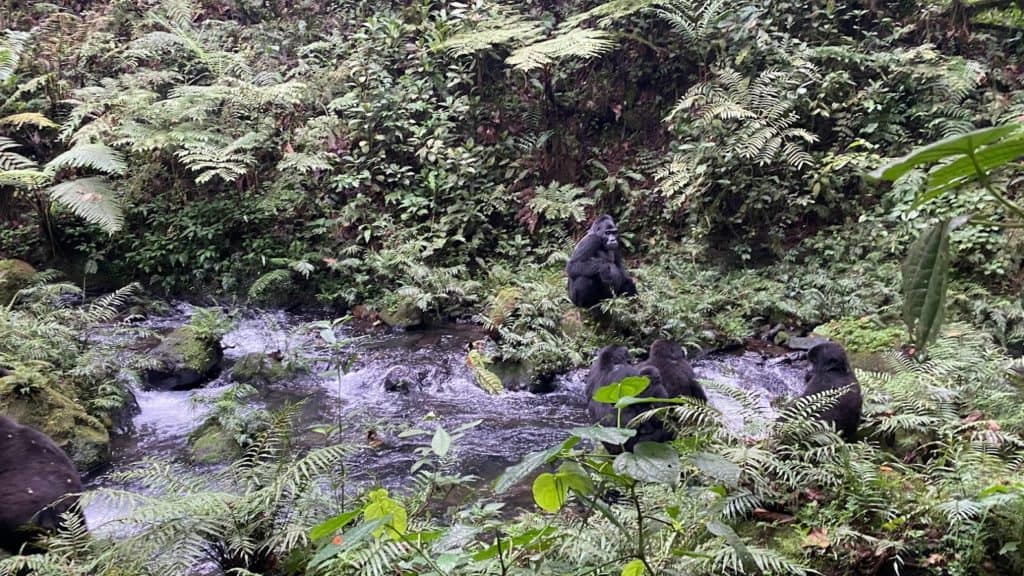
The entire gorilla family, following the head silverback, crosses the river eventually and climbs up its banks, continuing to move through the forest in search of food. We follow (quite comically as our porters hoist us across the river) and hike with the gorillas until they eventually stop at an area with some satisfactory vegetation and begin to forage and eat in earnest – some on the ground, others high in the trees.
We sit with Kanyweni, the third silverback in the family, as he rests and relaxes, rolling on his back and stretching, passing gas, and trying to sleep. As we are standing there, he decides suddenly to get up and move to a different spot – it turns out I am directly in his chosen path and at the front of our group in prime positioning for a close encounter. When confronted by a gorilla you are not supposed to make any sudden movements, so I freeze in place.
As he passes me, he throws his unthinkably large and stout hip into my leg and steps on the toe of my boot – it is enough force to knock me backward into our guide who catches me before I hit the ground (he apparently anticipated what Kanyweni was about to do and was ready to catch me). Although it feels like a brick wall has just run into me, I never once feel threatened or hurt, or scared in anyway. I was simply in his way. In all reality, I feel incredibly fortunate to have this accidental touch with Kanyweni and apparently, this means very good luck in Ugandan culture I later find out from Robert.
After observing Kanyweni for awhile longer, we locate the lead silverback who was eating nearby and being groomed by one of the females. As our group keeps our distance but circles around, he mock charges us with great fervor. My heart has not raced so hard as seeing a 400 pound animal with its large teeth bared charging right at us in the midst of a roaring scream. They tell you not to run – easier said than done – and while the rangers and trackers expertly move in front of our group and make a series comforting grunts and chest beats to communicate with the silverback that we are friendly – several of our group do indeed run. I am somehow able to refrain from bolting but instinct does push me into a speedy backward and sideways stumble out of the silverback’s path.
The Rushegura group is also home to a tiny 2-week-old baby – the youngest in Bwindi at the time of our visit – and we get a glimpse of this precious baby clinging to its mother’s chest as she moves across the forest floor. The group also includes a 1 year old baby and another young baby between 1 and 2 years.
Our hour with the Rushegura family seems to pass in an instant, though it is filled with more excitement than I possibly could have imagined. We debrief as we hike out of the forest and back to Park Headquarters to receive our Gorilla Trekking Certificates and bid farewell to our guide and porters – the tracker team has stayed behind with the gorillas to follow them to their nests for the night.
Of 50 families known to live in greater Bwindi, 23 are habituated. In the Buhoma sector where we are, there are currently 6 families habituated for trekking: Rushegura, Habinyanja, Mubare (the originals), Katwe, Muyambi and Binyindo.
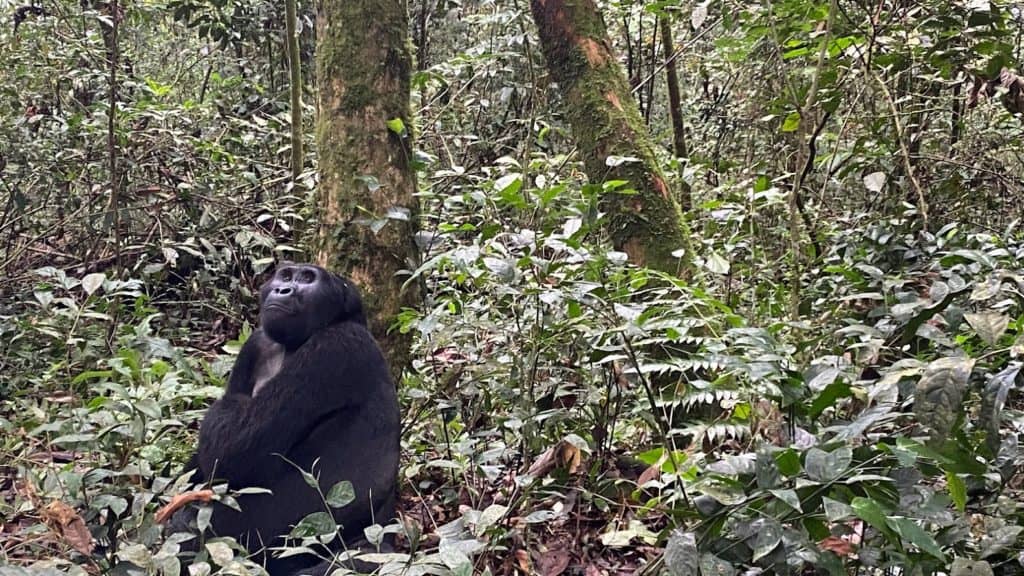
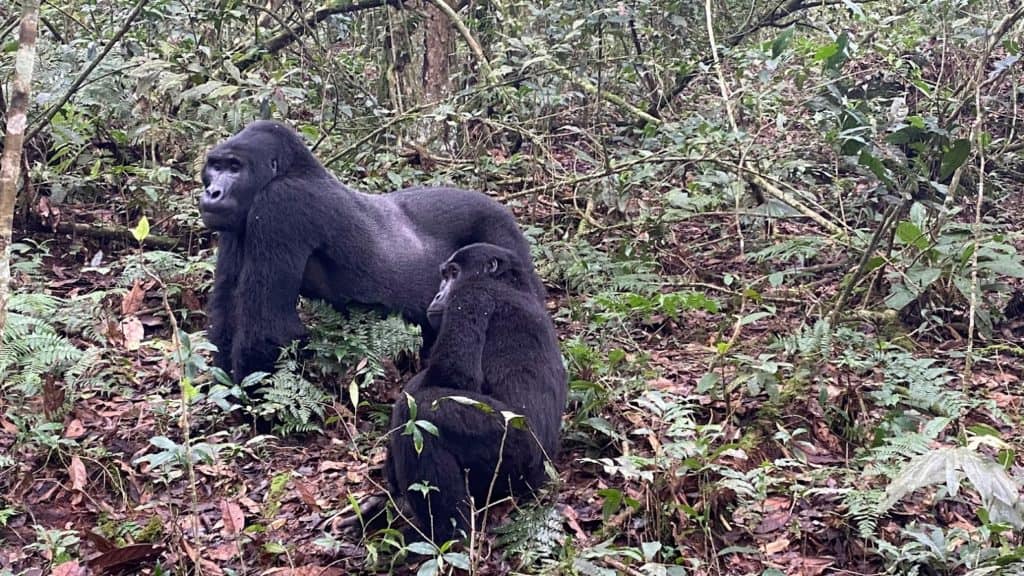
Following our trek, we have a chance for a site inspection at Bwindi Lodge (another Volcanoes Safaris property). The lodge is located just outside the park entrance with uninterrupted views of the forest and 10 total bandas (2 deluxe doubles, 2 family units and 6 standard doubles), a main dining and lounge area, and a spa. There is also a private trail from the lodge grounds into the Park for trekkers. Often, gorillas actually are spotted on the property. As a Volcanoes property, there are several community projects supported by the lodge, including the Bwindi Bar (a street facing pub where local youth train in hospitality), a tea growing demonstration where profits go back to the community, and the Bwindi Community Hospital. Guests can also go on the 45-minute self guided river loop walk from the lodge.
Sanctuary Gorilla Forest Camp is our next site inspection, and this tented camp is actually located within the Bwindi national park, giving it the most desirable location of all the lodges in the area. There are 10 tented cabins, a dining and lounge area, curio shop and fire pit where there is guest entertainment each night. At this camp the bar and laundry service are included (uncommon for Uganda but more typical of safaris elsewhere). It is a lovely luxury camp for those looking for a comfortable safari-style stay in Bwindi.
Departing from the park, we stop in Buhoma’s shopping district to pick up several crafts and souvenirs, and happen upon an amazing gallery called Bwindi Art – where talented local artists showcase and sell their work (follow @akampagodon on Instagram to check it out).
Gorilla Trekking Day 2
The next morning, we return to Park Headquarters for the same morning routine, but this time we are assigned to the Katwe family (“Katwe” means head). We pass by the Engagi cafe (“engagi” means gorilla) as we drive out of the main park entrance and back through Buhoma – the starting point for our trek today is on the other side of the park, and we drive about 15 minutes up a dirt road past endless local homes and farms, waving at everyone we see as pass through.
There is a constant stream of people hiking down the road and Robert tells us that there has been a death in the community of Buhoma – the mother of the landlord of Robert’s accommodation actually – and everyone is starting the long walk down to town for her funeral tonight (although the entire grieving ceremony lasts for about 3 days until the burial, and had already begun with people gathering for music and food at the home of the deceased’s family the previous night). Robert anticipates about 1,000 people to attend the funeral – shockingly, this is actually a smaller crowd than normal because of Covid.
Eventually we park and we, along with our guide Ozzie and two rangers Julius and Marco, unload from the car and set out on foot. We hike through the village, up and up a very steep trail, passing more homes and farms, goats grazing, chickens wandering, women and men tending their crops of corn, potatoes, bananas, or tea leaves, children playing and daily life going on around us. It feels great to be moving through the landscape on foot after so much time in a vehicle, driving past people instead of moving with them. After a few miles hiking up, we reach the edge of the forest and begin our trek in earnest.
Today’s trekking couldn’t be more opposite than yesterday’s fairly leisurely walk through the woods. Today we climb nearly vertical, hoisting, pulling and grabbing at vines, stepping endlessly over and on tree roots that cover the ground completely, around and through bushes, down steep muddy slopes and back up them. Almost immediately, there is not a trail at all and the rangers are quite literally bushwhacking through the forest with their machetes to clear a path. Within just a few minutes I fully understand why this forest is named Impenetrable. As we hike, we hear wild (non-habituated) chimpanzees calling in the distance.
With a constant hand from the porters (both my porter Solomon and my husband’s porter are helping me at this point), we reach the spot where the trackers have located the Katwe family. We are deep into thick jungle like I have never seen in my life and I am not quite sure how I will manage to follow the fast-moving Katwe family without the porters’ help through this terrain, but there is no other option.
The Katwe family is only 2 years into its habituation, and thanks to the lack of daily tourists due to Covid shutdowns and lower tourism, it is clear from the start that this group is still getting used to human presence as compared to the gorillas yesterday. The trackers and guide are constantly making comforting coughing sounds to indicate to the gorillas where we are and that we are not a threat. Still, almost as soon as we locate the group, a young adolescent male comes flying out of the vegetation in a very real-feeling mock charge. The guides tell us his name means “chaos initiator” – we are not at all surprised to hear that after his greeting.
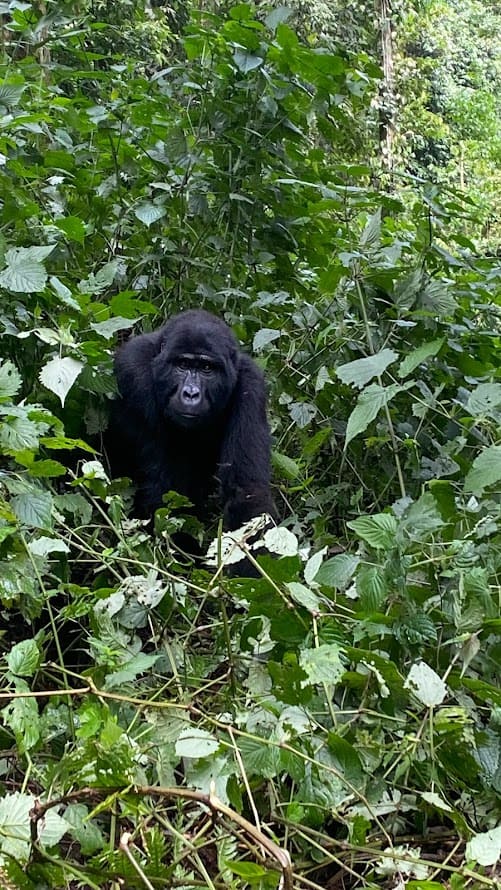
The group of 10 individuals moves constantly and swiftly, and we hike up and over, through and around, bushwhacking and climbing, catching glimpses of the lead silverback, several females, our friend Chaos Initiator (a blackback now but well on his way to being the third silverback), two babies, and the second silverback. For an hour we follow them in this manner and it is a stark contrast of experience between our two days of trekking – today feels more like following a wild pack of animals versus being allowed into a relaxed inner world. Both are special in their own ways, and the combination of the two different treks is exactly what we had hoped for. All told, we hike over 7 miles and a staggering 2,370 feet of elevation gain.
Ride 4 a Woman Project and Batwa Community Experience
We make it back to Robert’s vehicle, exhausted but happy, by about 3:00pm and head to the Bwindi Ride 4 a Woman Project to learn about this community organization that provides opportunities for local women in Buhoma. The director Mercy tells us over 300 women are part of the project. The project originally started in 2009 to empower women and create change in the community, beginning with renting out mountain bikes to tourists to fund a training program teaching women to be bike mechanics. Three years in, the program expanded to training women to sew, quilt and make baskets and to use these skills to support themselves and their families financially.
We are able to tour the center and see how the women quilt and sew, and purchase a few of the beautiful products they create. The project also provides microloans to women to start their own businesses in the community, and has a safe drinking water tap that anyone in the Buhoma community can access if they do not have a source of clean water.
86 children are also currently sponsored through the project, and the Hope of a Girl Child program brings in local girls every Friday for counseling and school tutoring. The center also teaches local cooking skills and how to harvest from your own garden. The women also showcase their culture through dance each morning at the gorilla trekking briefing. Visit the website or follow @ride4awoman on Instagram to get involved and learn more.
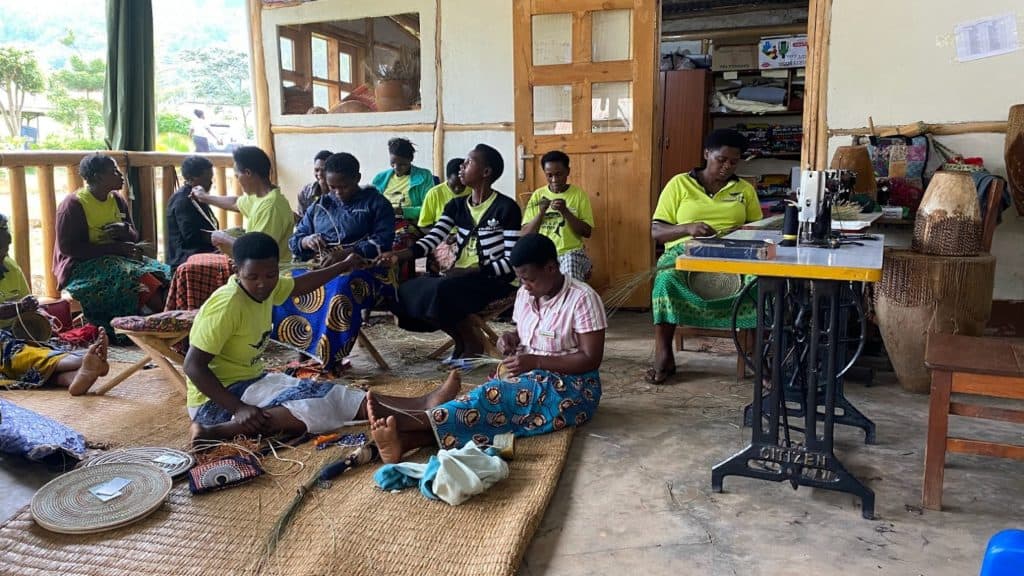
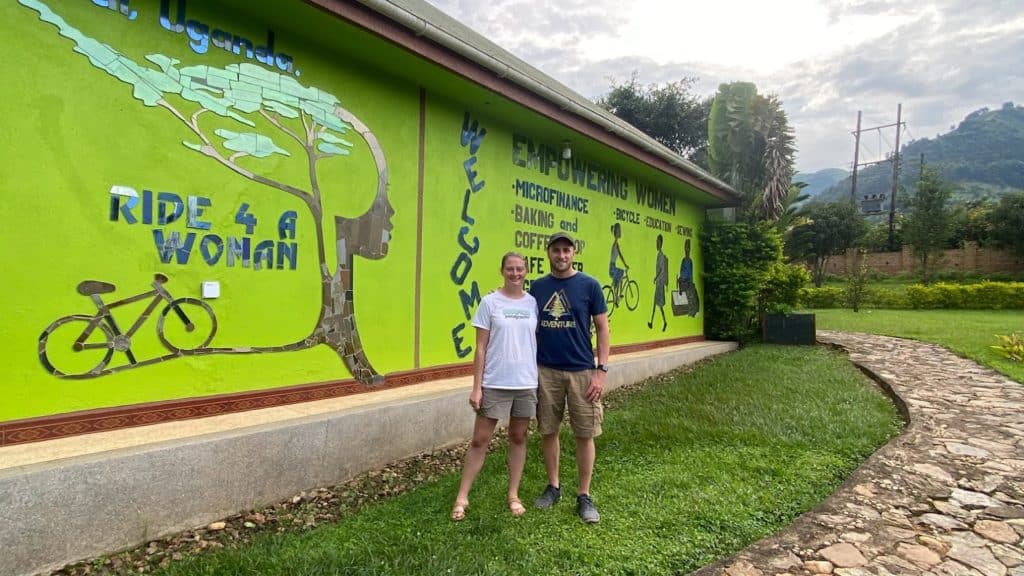
Following the Ride 4 a Woman Project, we set out to visit the Batwa community. The Batwa pygmy tribes were displaced from their homes in the forest when the Bwindi national park was formed in 1991, and have suffered a great disadvantage since then with the complete loss of their home and livelihood. As a result, the community is working to support themselves in a new way through tourism, and demonstrating their former ways of life to tourists who are visiting for gorilla trekking. We weren’t sure if we would have time to include this visit but we made it happen, and it ended up being one of the most impactful experiences of my life. These types of cultural visits can often be challenging to find authentic at best or can be uncomfortable at worst, however, the Buhoma Village Life & Batwa Tour experience is incredibly well done and the importance of supporting this community cannot be ignored.
Our tour guide Prince is absolutely delightful – charismatic, friendly and highly knowledgeable. He starts by teaching us many traditional ways of village life in Buhoma for the Bakiga people (about 15% of the population in Uganda), including a fascinating demonstration of how banana beer, banana wine and banana gin are made by local distillers.
We learn that it takes about 3 days for banana juice to ferment into banana beer which must be drank within 4-5 days. If you let the banana beer/wine continue to ferment, then distill, it becomes gin. Out of 100 liters of beer, you can get about 30-40 liters of gin. At the end of the process, we sip on banana gin and cheers to “Maisha marefu” – long life. We also learn and participate in making the local staple food of millet bread – a simple process of grinding millet grains down to flour, then mixing with water and cooking over an open flame into an unleavened, doughy bread. It is surprisingly satisfying dipped in peanut sauce, enjoyed with a local cup of coffee and new friends.
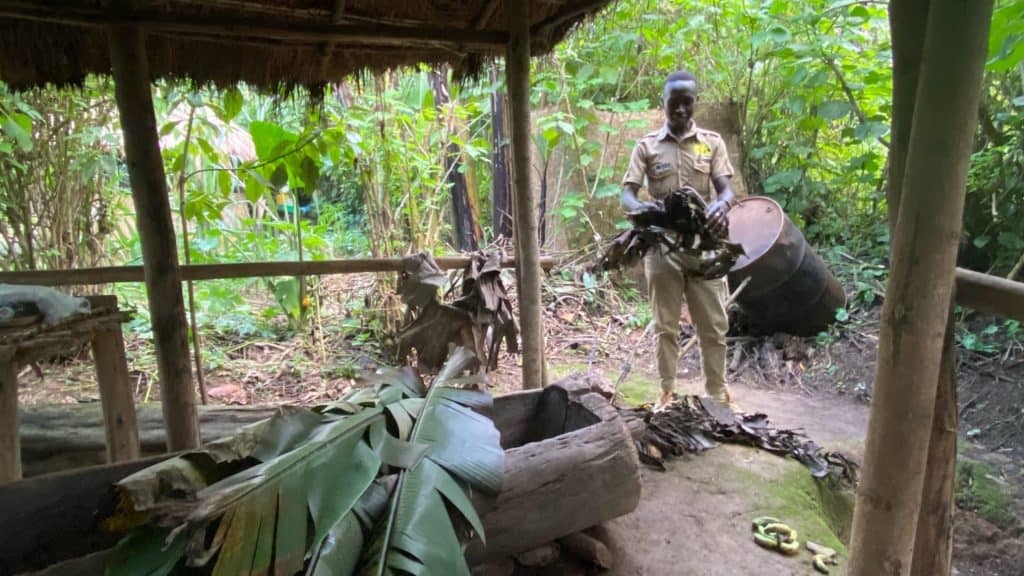
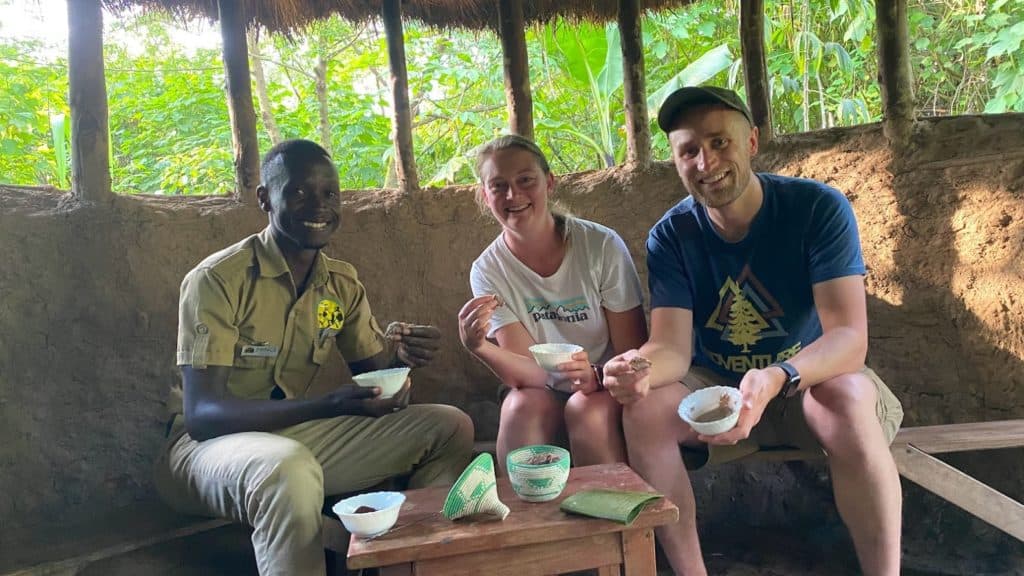
Prince then escorts us to the Batwa village, set up as a replica of how the Batwa lived in the Bwindi forest. It may be an example but the elder Batwa people here are the same who actually lived in the forest in the traditional way until the early 90s – I feel the same sense of undeserving privilege I felt when spending time with the Bushmen in Botswana – of all the people in the world, how am I here right now having the opportunity to meet and learn from some of the last remaining cultures who lived in a hunter-gatherer lifestyle for the last 30,000 years? How am I privileged enough to be learning from them firsthand while there are still people alive who actually lived in this way until ‘modern’ society forced them out of their lives?
The Batwa were a semi-nomadic group of hunter-gatherers known for their great skill in hunting and dancing. The leader of this group, Juma, demonstrates the way they build and set snares for pigs, duikers, buffalo and birds; build fire with only sticks and brush; and smoke honeybees out of their hives. I am again struck by the similarity of methods used by the Batwa and the Bushmen. At one point, our species was far more culturally connected than we now are. Juma and all of the Batwa people we meet do not speak any English, and Prince translates the demonstrations for us, along with Juma’s charismatic and enthusiastic gesturing.
Our experience concludes with watching a traditional dance performance (along with Juma picking along on a ukulele) and it is the honor of my life when I am invited to join the Batwa for a dance. I will never, ever forget dancing with this sweet little girl. It is the most special finale to our entire Uganda trip that I couldn’t have even imagined. We purchase several handmade baskets and bracelets before bidding fond farewell.
Farewell to Uganda
The drive from Buhoma to the Kihihi airstrip takes about 1 hour and 15 minutes, and along the way we pass minibuses overloaded and swelling with goods for the market day in Butogota. Butogota is just a hair away from the DRC border and many Congolese will come across the border for market day today.
As we wait for our bush plane at the airstrip, a huge flock of Crested Cranes flies over the airstrip and it feels like a proper sendoff. They land in the airstrip and we chuckle at the runway crew who has to chase them off before the plane lands. We board our 11-seater AeroLink plane, and fly low enough – about 9,600 feet – that we have a beautiful scenic flight of about 1 hour and 10 minutes flight time. Our pilots Roman and Nixon do a great job and it’s a lovely smooth flight all the way to Entebbe. We have a stunning aerial view of Lake Victoria, the second largest lake in the world after Lake Superior.
From the airport we head to The Boma Guesthouse for a Covid test, lunch and checking into our room. The Boma is a great midrange basic guesthouse for a quick stop in Entebbe. There is a nice pool area, two dining rooms, and 16 guest rooms. The courtyard offers serene greenery and lots of bird life. There is A/C available which is a nice treat.
Robert is driving on the long journey back from Bwindi, so we head out with our second guide from Classic Africa, Stanley, who has spent 18 years with Classic. We have a chance to visit the team at the Classic Africa offices and meet with general manager Hilda – so wonderful to put in face time with our partners in Uganda after working daily with them via email!
We then get to tour the incredible Classic Africa Safaris custom vehicle workshop with Mel Gormley, co-founder of Classic, and meet some of the amazing mechanics, tailors and staff who make these top of the line safari vehicles. Classic supports about 31 employees at this facility, and in turn supports approximately 400 people when including families. They are also one of the first Uganda tour companies to be carbon neutral for all of their safaris – an amazing feat. Following the workshop, we have a site inspection at Hotel No. 5, a nice upscale hotel option in Entebbe with a large courtyard, private pool, several types of room options and a restaurant.
The next morning, our negative Covid certificate printouts are given to us at the front desk, and we are surprised by Robert in the hotel lobby. He is back from the long drive and will see us off today before having a couple of weeks off to spend time with his family. We pop by the Protea Marriott hotel for a final site inspection. The hotel is completely full thanks to a conference, so we don’t tour any rooms but we visit the main areas of the hotel and stroll along the hotel’s courtyard which is located right on the edge of Lake Victoria. It’s a beautiful setting for the 86 room luxury hotel, and there is also a pool, sauna, steam room and gym available for guests.
After a whirlwind of 9 days, our trip comes to a close with a final goodbye to Robert at the airport. We make our way onward, taking with us the memories of a lifetime.